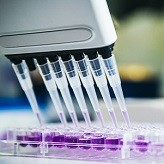Three winning projects for the 2020 Biomedical Innovation Program


Focusing on a new Covid-19 detection method, endothelial diseases and chromosomal abnormalities in oocytes, the winning projects from the 2020 call for projects of the "Biomedical Innovation Program" have just been announced. This program, which has been supported by the Bettencourt Schueller Foundation since its creation in 2018, aims to help the development of projects that focus on personalised, connected or targeted care, or knowledge directly applicable to the improvement of human health.
The two-year projects supported by the Program are co-directed by a researcher and a doctor and their advances are presented at the annual Biomedical Engineering Symposium organised within the Program. The three winning projects of the AAP 2020 are the following:
NASCA: at the heart of the current pandemic
The first project, called NASCA, develops a Covid-19 detection tool that is faster than the PCR test and can be deployed in situ. Indeed, the test currently deployed is based on a multitude of virus RNA replications (RT-PCR test) and has an incompressible time of realization in the laboratory. Cédric Bouzigues (bioimaging researcher at the Optics and Biosciences Laboratory - École Polytechnique) and Bruno Lina (head of the National Reference Centre for Enteroviruses and Paréchoviruses at Lyon University Hospital and Croix Rousse Hospital) are looking to set up a test using rare earth nanoparticles. These particles are capable of optical detection of precise molecules, in this case viral RNAs, theoretically enabling highly sensitive immunoassays to be carried out. In the long term, NASCA will thus provide a powerful tool that can be deployed on site (stations, factories, schools, etc.) and which almost immediate results will be integrated into a strategy for tracing the pandemic in real time.
Understanding genetic blood vessel diseases
A fine example of serendipity, the second project is based on the observation of a phenomenon of "trapping" of endothelial cell nuclei cultivated in vitro. These cells form the walls of blood vessels in vivo and are permanently subjected to high pressure. In cell cultures imitating the physiological conditions, the nucleus is abnormally confined in one part of the endothelial cells. This sequestration is similar to that observed in laminopathies, rare diseases that cause a structural anomaly of the nucleus. Led by Abdul Barakat (bioengineering researcher at the Laboratoire d’hydrodynamique de l’X - École Polytechnique) and Catherine Coirault (director of the "Mechanobiology and muscle disorders" group at the Institute of Myology), this project will study the possibilities of using this type of culture to simply and effectively diagnose these diseases.
Choosing the right oocytes with MicrOART
The project led by Clément Campillo (researcher in biophysics at the Laboratory of Analysis, Modelling, Materials for Biology and the Environment - University of Evry) and Elsa Labrune (Department of Medicine and Reproduction, Hospices Civils de Lyon), called MicrOART, seeks to solve problems of chromosomal anomalies. In fact, their previous studies have proved that certain mechanical properties of oocytes, the precursors of eggs, were indicative of their good development or the presence of genetic abnormalities. They wish to use this knowledge to develop an oocyte selection method that can be used mainly for medical aid in procreation.
About the Program:
The constant medical evolution presents the development of a more personalised, connected and targeted medicine as one of the challenges. In order to meet these challenges, the "Biomedical Innovation Program", supported by the Bettencourt Schueller Foundation, funds innovative research projects to link physical scientists/engineers and physicians. The Program, led since 2018 by Abdul Barakat, thus accelerates the integration of innovative techniques and technologies in the medical field.
Sponsor: Abdul Barakat, CNRS research director at the Hydrodynamics Laboratory (LadHyX - joint CNRS - École polytechnique research unit) and professor at the École polytechnique de l'Institut Polytechnique de Paris.
About the Bettencourt Schueller Foundation: "Giving wings to talent".
The Bettencourt Schueller Foundation supports and promotes people who imagine tomorrow's world today in three areas that contribute concretely to the common good: life sciences, arts and solidarity. Since its creation at the end of the 1980s, it has rewarded 594 prize winners and supported more than 1000 projects led by talented individuals, teams, associations and organisations.
More information on www.fondationbs.org
 Support l'X
Support l'X